
Emergency measure makes Historic Lower Manhattan 101st on Watch list

Associate Editor
The World Monuments Fund (WMF) announced on October 11 its biennial Watch List of the top 100 imperiled historic, architectural, and cultural sites worldwide. As an emergency measure, WMF also added Historic Lower Manhattan as the 101st site on the endangered list.
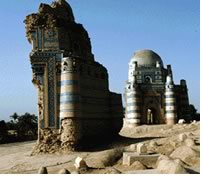 The
authors of the report note that it is sobering that acts of destruction
are not limited to the battlefield, but "at the cultural icons that
bind and inspire communities around the world." They continue, "Our
landmarks—the Mostar Bridge, the Bamiyan Buddhas in Afghanistan,
and the World Trade Center—have become the prized targets for terrorists
because they are what defines the cultures, ideals, and achievements of
people who created them, who use them, who live with them."
The
authors of the report note that it is sobering that acts of destruction
are not limited to the battlefield, but "at the cultural icons that
bind and inspire communities around the world." They continue, "Our
landmarks—the Mostar Bridge, the Bamiyan Buddhas in Afghanistan,
and the World Trade Center—have become the prized targets for terrorists
because they are what defines the cultures, ideals, and achievements of
people who created them, who use them, who live with them."
Five continents and
50 countries
The list spans five continents and 50 countries. It includes sites with
diverse geographic, cultural, and national origins. It features well-known
landmarks, such as the Great Wall of China, and less well-known sites,
such as Terezin Fortress, Czech Republic, and Pervomaisk Church, Belarus.
U.S. sites include the A. Conger Goodyear House, Old Westbury, N.Y.; San
Esteban del Rey Mission, Acoma Pueblo, N.M.; St. Ann and the Holy Trinity
Church, Brooklyn, N.Y.; San Capistrano Mission Church, San Capistrano,
Calif.; and Schindler Kings Road House and Studio, West Holywood, Calif.
A prior list included architect Richard Neutra's Los Angeles home.
 Site
types include religious buildings, archaeological sites, townscapes, military
structures, civic buildings, dwellings, cultural landscapes, palaces,
engineering works, and industrial sites. They can be seen in the book,
Vanishing Histories: 100 Endangered Sites
from the World Monuments Watch, authored by Colin Amery, a former
architectural correspondent for the London
Financial Times, with Brian Curran Jr. of the WMF. It will be published
by Harry N. Abrams, Inc.
Site
types include religious buildings, archaeological sites, townscapes, military
structures, civic buildings, dwellings, cultural landscapes, palaces,
engineering works, and industrial sites. They can be seen in the book,
Vanishing Histories: 100 Endangered Sites
from the World Monuments Watch, authored by Colin Amery, a former
architectural correspondent for the London
Financial Times, with Brian Curran Jr. of the WMF. It will be published
by Harry N. Abrams, Inc.
The watch list is a call to action, and organizers say it is often the only hope for cultural monuments that are threatened by the calamities of "pollution, natural disasters, neglect, uncontrolled tourism, and wanton destruction." Intervention has helped rescue some of the ailing properties: 73 percent of the 1998 sites are now off the endangered list and are improving. Since the beginning of the watch program, more than 226 grants to 128 sites in 60 countries have been awarded a total of $12.6 million, in addition to millions more directly leveraged to the sites.
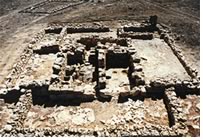 A
panel representing several international organizations selected the sites,
which they culled from nominations submitted to WMF by governments, organizations,
and people active in cultural preservation. Only sites that are nominated
may be considered.
A
panel representing several international organizations selected the sites,
which they culled from nominations submitted to WMF by governments, organizations,
and people active in cultural preservation. Only sites that are nominated
may be considered.
The WMF also promotes other initiatives, such as the Jewish Heritage Program, to identify and preserve historic Jewish sites abandoned during World War II, and the European Preservation Program, which focuses on assessing and repairing damage to cultural monuments in former Communist-bloc countries.
![]()
|
The World Monument Fund has published the 2002 World Monuments Watch List of 101* Most Endangered Sites. The brand new book, Vanishing Histories: 100 Endangered Sites from the World Monuments Watch, will soon be available at the AIA Bookstore. Call 800-242-3837 (menu option 4) to place your order. |
|
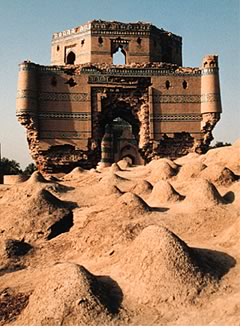 The
Uch Monument Complex, located in the Bahawalpur District, Pakistan, is
the home of tile-bedecked mausoleums built in the 15th and 16th centuries.
The tombs suffered severe damage in a 19th century flood, and attempts
to repair them (with cement) further compromised their preservation.
The
Uch Monument Complex, located in the Bahawalpur District, Pakistan, is
the home of tile-bedecked mausoleums built in the 15th and 16th centuries.
The tombs suffered severe damage in a 19th century flood, and attempts
to repair them (with cement) further compromised their preservation.
Photo courtesy World Monuments Fund
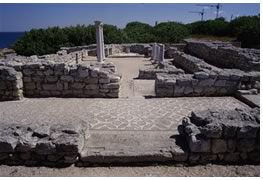 Chersonesos,
Sevastapol, Ukraine, is called the "Ukrainian Pompeii" because
the colony on the Black Sea, which was founded in the 5th century, offers
such well-preserved examples of Roman and Hellenic remains. The site,
which sits on the north coast of the Black Sea, is severely threatened
by coastal erosion and an almost total lack of funding for preservation.
Chersonesos,
Sevastapol, Ukraine, is called the "Ukrainian Pompeii" because
the colony on the Black Sea, which was founded in the 5th century, offers
such well-preserved examples of Roman and Hellenic remains. The site,
which sits on the north coast of the Black Sea, is severely threatened
by coastal erosion and an almost total lack of funding for preservation.
Photo by Joseph Carter
 Ohel
Rachel Synagogue, Shanghai, China, one of the few remaining buildings
bearing witness to the pre-1949 population of more than 25,000 Jews, is
the only remaining synagogue (out of seven) in the city. Although confiscated
by the Chinese government in 1952, the building has remained largely intact
(in part due to landmark status achieved in 1993), and its again-growing
Jewish community is spearheading the movement to return it to its 1920s
condition and use as a house of worship and museum.
Ohel
Rachel Synagogue, Shanghai, China, one of the few remaining buildings
bearing witness to the pre-1949 population of more than 25,000 Jews, is
the only remaining synagogue (out of seven) in the city. Although confiscated
by the Chinese government in 1952, the building has remained largely intact
(in part due to landmark status achieved in 1993), and its again-growing
Jewish community is spearheading the movement to return it to its 1920s
condition and use as a house of worship and museum.
Photo by Adam Glasser
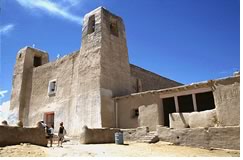 San
Esteban del Rey Mission, Acoma Pueblo, New Mexico, is part of a Native
American community that has been continuously inhabited for 1,000 years,
making it the oldest community in the U.S. The stone-and-adobe mission
itself was built in the "Sky City" under the direction of Father
Juan Ramirez by the Acoma people, who consider the spirits of their ancestors
to be within the walls. Despite the serious preservation efforts by tribal
members, the mission is threatened by ground-level erosion and severe
roof deterioration, making it a prime candidate for a comprehensive preservation
program.
San
Esteban del Rey Mission, Acoma Pueblo, New Mexico, is part of a Native
American community that has been continuously inhabited for 1,000 years,
making it the oldest community in the U.S. The stone-and-adobe mission
itself was built in the "Sky City" under the direction of Father
Juan Ramirez by the Acoma people, who consider the spirits of their ancestors
to be within the walls. Despite the serious preservation efforts by tribal
members, the mission is threatened by ground-level erosion and severe
roof deterioration, making it a prime candidate for a comprehensive preservation
program.
Photo by G. Lendvai
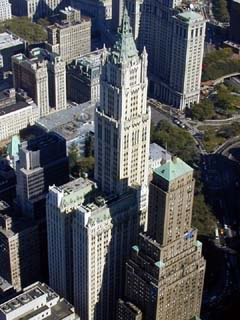 *The
World Monuments Watch has designated Historic Lower Manhattan as its 101st
Most Endangered Site in the wake of the September 11 devastation. The
area, which dates to 1625, contains more than 65 landmarks in six historic
districts, and—from Trinity Church to the Woolworth Building (shown
left) —offers a history lesson of the evolution of American architecture.
"Landmark quality buildings that are not officially listed as landmarks
are particularly at risk in the reconstruction process," the World
Monuments Watch also reminds us. "It is important that historic preservation
have a voice in the public dialogue regarding the restoration of New York,
a critical step in the healing process as the city rebuilds its sense
of place."
*The
World Monuments Watch has designated Historic Lower Manhattan as its 101st
Most Endangered Site in the wake of the September 11 devastation. The
area, which dates to 1625, contains more than 65 landmarks in six historic
districts, and—from Trinity Church to the Woolworth Building (shown
left) —offers a history lesson of the evolution of American architecture.
"Landmark quality buildings that are not officially listed as landmarks
are particularly at risk in the reconstruction process," the World
Monuments Watch also reminds us. "It is important that historic preservation
have a voice in the public dialogue regarding the restoration of New York,
a critical step in the healing process as the city rebuilds its sense
of place."
Photo courtesy Wired
New York
![]()
Copyright 2001 The American Institute of Architects. All rights reserved.
![]()